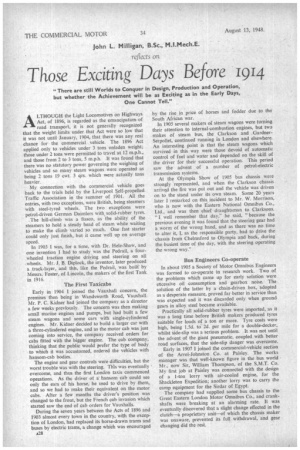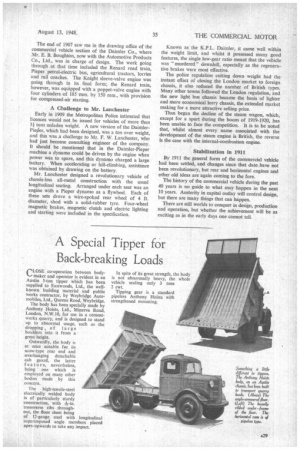John L. Milligan, B.Sc., M.I.Mech.E. reflects on Those Exciting Days Before 1914
Page 30

Page 31

If you've noticed an error in this article please click here to report it so we can fix it.
There are still Worlds to Conquer in Design, Production and Operation, but whether the Achievement will be as Exciting as in the Early Days, One Cannot Tell."
ALTHOUGH the Light Locomotives on Highways Act, of 1896, is regarded as the emancipationof road transport, it is not generally recognized
that the weight limits under that Act were so low that it was not until January, 1904, that there was any real chance for the commercial vehicle. The 1896 Act applied only. to vehicles under 3 tons unladen weight; those under 2 tons were permitted to travel at 12 m.p.h., and those from 2 to 3 tons, 5 m.p.h. It was found that there was no statutory power governing the weighing of vehicles and so many steam wagons were operated as being 2 tons 19 cwt. 3 qrs. which were actually tons heavier.
My connection with the commercial vehicle goes back to the trials held by the Liverpool Self-propelled Traffic Association in the summer of 1901. All the entries, with two exceptions, were British, being steamers with steel-tyred wheels. The two exceptions were petrol-driven German Daimlers with solid-rubber tyres. .The hill-climb was a fiasco, as the ability of the steamers to hold a steady head of steam while waiting to make the climb varied so much. One fast starter could only just finish, but it came well up on average speed.
In 1903 1 was, for a time, with Dr. Hele-Shaw, and one invention I had to study was the Ped rail, a fourwheeled traction engine driving and steering on all .wheels. Mr. J. B. Diplock, the inventor, later produced a track-layer, and this, like the Pedrail, was built by Messrs. Foster, of Lincoln, the makers of the first Tank in 1916.
The First Taxicabs
Early, in 1904 I joined the Vauxhall concern, the premises then being in Wandsworth Road, Vauxhall. Mr. P. C. Kidner had joined the company as a director a few weeks previously. The concern was then making small marine engines and pumps, but had built a few steam wagons and some cars with single-cylindered engines. Mr. Kidner decided to build a larger car with a three-cylindered engine, and as the motor cab was just coming into service, the company received orders for cabs fitted with the bigger engine. The cab company, thinking that the public would prefer the type of body • to which it was accustomed, ordered the vehicles with hansom-cab bodies.
The engine and gear controls were difficulties, but the worst trouble was with the steering. This was eventually overcome, and thus the first London taxis commenced operations. As the driver ot a hansom cab could see only the ears of his horse, he used to drive by them, and so we had to make their equivalent on the motor cabs. After a few months the driver's position was changed to the front, but the French cab invasion which started saw the end of cab orders for Vauxhalls.
During the seven years between the Acts of 1896 and 1903 almost every town in the country, with the exception of London, had replaced its horse-drawn trams and buses by electric trams, a change which was encouraged A28 by the rise in price of horses and fodder due to the South African war.
In 1905 several makers of steam wagons were turning their attention to internal-combustion engines, but two makes of steam bus, the Clarkson and .GardnerSerpollet, continued running in London and elsewhere. An interesting point is that the steam wagons which survived in this way were those devoid of automatic control of fuel and water and depended on the skill of the driver for their successful operation. This period saw the advent of a number of petrol-electric transmission systems.
At the Olympia Show of 1905 bus chassis were strongly represented, and when the Clarkson chassis arriveid the fire was put out and the vehicle was driven on to the stand under its own steam. Some 20 years later I remarked on this incident to Mr. W. Morrison, who is now with the Eastern National Omnibus Co., Ltd., and was then chief draughtsman to Clarksons. "I well remember that day," he said, "because the previous evening it was found that the steering gear had a worm of the wrong hand, and as there was no time to alter it, 1, as the responsible party, had to drive the chassis from Chelmsford to Olympia and back, during the busiest time of the day, with the steering operating the wrong way."
Bus Engineers Co-operate In about 1905 a Society of Motor Omnibus Engineers was formed to co-operate in research work. Two of the problems which came up for early solution were excessive oil consumption and gearbox noise. The solution of the latter by a chain-driven box, adopted as a desperate measure, proved far better in service than was expected and it was discarded only when ground gears in alloy, steel became available.
Practically all solid-rubber tyres were imported, as it was a long time before British makers produced tyres suitable for loads of a ton or more. Tyre costs were high, being I.5d. to 2d. per mile for a double-decker, whilst side-slip was a serious problem. It was not until the advent of the giant pneumatic, coupled with better road surfaces, that the side-slip danger was overcome.
Early in 1907 I joined the commercial-vehicle section of the Arrol-Johnston Co. at Paisley. The works manager was that well-known figure in the bus world Mr., now Sir, William Thompson, of the S.M.T. Co. My first job at Paisley was connected with the design of a 1-ton lorry with air-cooled engine, for the Shackleton Expedition; another lorry was to carry the camp equipment for the Sirdar of Egypt.
The company had supplied some bus chassis to the Great Eastern London Motor Omnibus Co_, and crankshafts were breaking at an alarming rate. It was eventually discovered that a slight change effected in the clutch—a proprietary unit—of which the chassis maker was unaware, prevented its full withdrawal, and gear changing did the rest. The end of 1907 saw me in the drawing office of the commercial vehicle section of the Daimler Co., where Mr. E. B. Boughton, now with the Automotive Products Co., Ltd., was in charge of design. The work going through at that time included the Renard road train, Pieper petrol-electric bus, agricultural tractors, lorries and rail coaches. The Knight sleeve-valve engine was going through in its final form; the Renard train, however, was equipped with a poppet-valve engine with four cylinders of 185 mm. by 150 mm., with provision for compressed-air starting.
A Challenge to Mr. Lanchester Early in 1909 the Metropolitan Police intimated that licences would not be issued for vehicles of more than 31 tons unladen weight. A new version of the DaimlerPiejier, which had been designed, was a ton over weight, and this was a challenge to Mr. F. W. Lanchester, who had just become consulting engineer of the company. It should be mentioned that in the Daimler-Pieper machine a dynamo could be driven by the engine when power was to spare, and this dynamo charged a large battery. When accelerating or hill-climbing, assistance was obtained by drawing on the battery.
Mr. Lanchester designed a revolutionary vehicle of chassis-less all-metal construction with the usual longitudinal seating. Arranged under each seat was an engine with a Pieper dynamo as a flywheel. Each of these sets drove a wire-spoked rear wheel of 4 ft. diameter, shod with a solid-rubber tyre. Four-wheel magnetic brakes, magnetic clutch and electric lighting and starting were included in the specification.
Known as the K.P.L. Daimler, it came well within the weight limit, and whilst it possessed many good features, the single low-gear ratio meant that the vehicle was " murdered " downhill, especially as the regenerative brakes were most effective.
The police regulation cutting down weight had the instant effect of closing the London market to foreign chassis, it also reduced the number of British types. Many other towns followed the London regulation, and the new light bus chassis became the basis of lighter and more economical lorry chassis, the extended market making for a more attractive selling price.
Thus began the decline of the steam wagon, which, except for a spurt during the boom of 1919-1920, has been unable to face the competition. It is to be noted that, whilst almost every name associated with the development of the steam engine is British, the reverse is the case with the internal-combustion engine.
Stabilization in 1911
By 1911 the general form of the commercial vehicle had been settled, and changes since that date have not been revolutionary, but rear and horizontal engines and other old ideas arc again coming to the fore.
The history of the commercial vehicle during the past 40 years is no guide to what may happen in the next 10 years. Austerity in capital outlay will control design, but there are many things that can happen.
There are still worlds to conquer in design, production and operation, but whether the achievement will be as exciting as in the early days one cannot tell.












































































